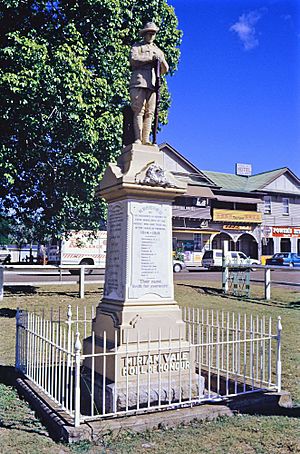Miriam Vale War Memorial facts for kids
Quick facts for kids Miriam Vale War Memorial |
|
|---|---|

Miriam Vale War Memorial, 1995
|
|
| Location | Blomfield Street, Miriam Vale, Gladstone Region, Queensland, Australia |
| Design period | 1919 – 1930s (interwar period) |
| Built | 1921 |
| Official name: Miriam Vale War Memorial | |
| Type | state heritage (landscape, built) |
| Designated | 21 October 1992 |
| Reference no. | 600725 |
| Significant period | 1921– (social) 1921– postWWII (historical, fabric) |
| Significant components | fence/wall – perimeter, memorial – soldier statue, flagpole/flagstaff, park / green space, memorial surrounds/railings |
| Lua error in Module:Location_map at line 420: attempt to index field 'wikibase' (a nil value). | |
The Miriam Vale War Memorial is a special monument in Miriam Vale, Queensland, Australia. It was built in 1921 to remember local people who bravely served in wars. This important site is listed on the Queensland Heritage Register.
A Look Back in Time
The Miriam Vale War Memorial was put up in 1921. It was built to honor the local men who lost their lives in World War I. People in the community helped raise money for it. They collected about £238, which was a lot of money back then!
A company from Brisbane called AL Petrie & Son designed and built the memorial. This company made many soldier statues for war memorials across Queensland. The Miriam Vale memorial was a unique design for them.
The memorial was officially revealed on December 14, 1921. A politician named John William Fletcher, who represented the area, did the honors.
Later, another message was added to the memorial. This message remembers those who died serving in World War II. The wooden fence around the memorial was added more recently.
What Does It Look Like?
The Miriam Vale War Memorial stands at one end of a long, grassy park. This park is next to the railway line and Bloomfield Street. Bloomfield Street is the main street in Miriam Vale. The memorial faces the morning sun and the Miriam Vale railway station. It's a main feature at the southern end of the town's business area.
The memorial has a life-sized stone statue of an Australian soldier. The soldier stands with his head bowed, holding his rifle. This statue sits on a large, fancy stone base called a pedestal. The pedestal rests on a granite base.
The top of the pedestal has a sloped roof-like shape with a carved wreath. On the front of the pedestal, there's a marble plate. It lists the names of 13 "brave boys of this district who gave their all in the cause of freedom 1914–1919." It also has the famous words: "Their names liveth for evermore." This phrase is often found in British war cemeteries.
Another plate on the side lists the names of 8 local men. These men died during World War II. The words "Miriam Vale Roll of Honour" are written on the concrete base.
The monument is surrounded by its original concrete border and an iron fence. There's a gate at one corner. A wooden fence with wrought-iron gates also surrounds this area.
A tall pole for a flag stands near the memorial. A very large fig tree also stands nearby. This tree and other fig trees in Miriam Vale are very old, possibly from the early 1900s.
Why Is It Important?
The Miriam Vale War Memorial is important for several reasons:
- It tells a story: It shows how communities in Queensland remembered their soldiers after the world wars. It also shows how Australians felt about their country at that time.
- It's unique: While many towns have soldier monuments, the specific design of the pedestal on the Miriam Vale memorial is quite rare.
- It's a landmark: The memorial is a key feature in Miriam Vale. It adds a lot to the look of Bloomfield Street.
- It connects to history: It's linked to the work of AL Petrie & Son. This company played a big part in creating many of Queensland's World War I memorials. They helped make the "digger" soldier statue popular.

